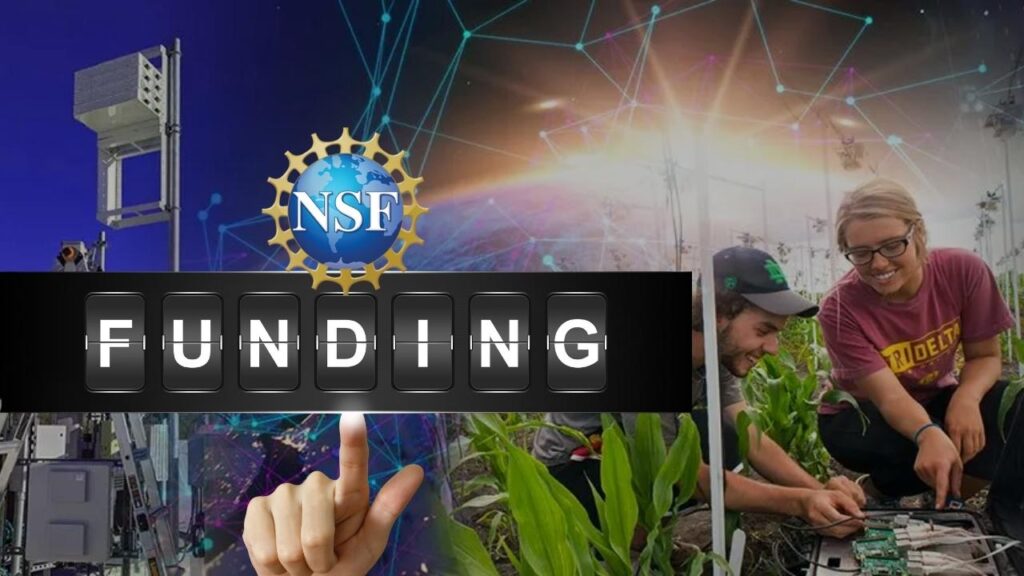NSF Announces New Funding for NextG Wireless Research: The National Science Foundation (NSF) has recently unveiled a significant funding initiative to accelerate research and development in NextG wireless technologies, setting the stage for transformative advances in global telecommunications. With a total funding commitment of up to $100 million, the NSF’s program, officially named VERTICALS-enabling Intelligent NEtwork Systems (VINES), is designed to foster innovations that will enable ultra-fast, intelligent, secure, and adaptive wireless networks beyond the current 5G infrastructure.

NextG wireless technologies are expected to be the backbone of future digital ecosystems, connecting everything from autonomous vehicles and industrial robots to smart cities and remote medical care. This article explores the details of the NSF VINES funding program, its strategic importance, practical implications, and how it supports the development of the wireless technologies that will shape the coming decades.
Table of Contents
NSF Announces New Funding for NextG Wireless Research
| Feature | Details |
|---|---|
| Program Name | Verticals-enabling Intelligent NEtwork Systems (VINES) |
| Funding Amount | Up to $100 million over 5 years |
| Administered by | U.S. National Science Foundation |
| Research Focus | Edge-to-core-cloud networks, AI integration, resilient infrastructure, cyber-physical systems |
| Industry Partners | Intel, Qualcomm, Ericsson, and others |
| Government Collaborators | Department of Defense (DoD), Department of Homeland Security (DHS) |
| International Collaborators | Japan, India, Sweden, Finland, among others |
| Tracks | Track 1: Fundamental Research; Track 2: Technology Development and Translation |
| Target Applications | Healthcare, autonomous vehicles, smart manufacturing, agriculture, disaster recovery, defense |
| Workforce Development | Training programs for next-generation telecom and AI professionals |
| Proposal Deadline | Varies; see NSF VINES Program Solicitation |
The NSF’s VINES program, with up to $100 million in funding, represents a crucial investment in NextG wireless research and technology development. By focusing on intelligent, adaptive, and secure wireless networks, the program not only supports fundamental scientific advances but also ensures that new technologies are deployed in real-world environments across critical sectors.
Through strong industry and international partnerships, and a dedicated emphasis on workforce development, the NSF initiative is well-positioned to accelerate innovation and maintain U.S. leadership in telecommunications. The impact of this work will be felt in healthcare, transportation, manufacturing, agriculture, and national security, transforming how people live and work in the coming decades.
What Is NextG Wireless Technology?

NextG refers to the next generation of wireless networks designed to surpass 5G by offering faster data speeds, extremely low latency, increased reliability, enhanced security, and the capability to connect a vast number of devices simultaneously. While 5G networks improved mobile broadband and enabled smart city applications, NextG will integrate emerging technologies such as:
- Artificial Intelligence (AI) and Machine Learning (ML) for dynamic network optimization and self-healing capabilities.
- Edge computing, which processes data closer to where it is generated, reducing latency and bandwidth needs.
- Quantum communications and sensing, providing enhanced security and new functionalities.
- Cyber-physical systems, tightly integrating computation with physical processes, crucial for robotics, manufacturing, and autonomous systems.
The goal is to build networks that can adapt intelligently in real time to changing conditions, supporting mission-critical applications like remote surgeries, emergency response, and autonomous vehicles with near-perfect reliability.
NSF’s VINES Program: Bridging Research and Real-World Impact

The VINES program is an ambitious effort aimed at catalyzing research from basic science through applied development and deployment.
Dual-Track Structure for Maximum Impact
- Track 1 – Use-Inspired Fundamental Research
This track supports projects that advance the scientific foundations of intelligent network systems. This includes novel AI algorithms for adaptive networking, new protocols to improve security and privacy, and theoretical frameworks for resilient communications. The research here lays the groundwork for future applications by understanding fundamental limits and capabilities. - Track 2 – Technology Development and Translation
Projects funded under this track focus on building and testing prototypes of NextG wireless systems in real-world environments. This includes creating hardware/software systems for smart factories, connected vehicles, telemedicine platforms, and more. By validating these systems outside the lab, Track 2 aims to accelerate adoption and commercialization.
Why This Matters
By combining foundational research with applied technology development, the NSF ensures that innovations are not only visionary but also practical and scalable. This dual approach reduces the time between discovery and impact.
Practical Applications and Benefits
NextG technologies will revolutionize many industries and daily life by providing reliable, instantaneous wireless connectivity at scale.
Healthcare and Telemedicine
NextG networks will enable remote robotic surgeries with near-zero lag, vital in rural or underserved areas. AI-powered diagnostics will operate in real-time, providing instant feedback to doctors and patients. This could save lives and reduce healthcare costs globally.
Autonomous Vehicles and Transportation
Vehicles will communicate directly with each other and traffic systems to prevent accidents and improve traffic flow. NextG’s ultra-low latency ensures safety-critical information is transmitted immediately, supporting the deployment of fully autonomous fleets.
Smart Manufacturing and Industry 4.0
Factories will use sensor networks connected via NextG to monitor equipment health and automatically adjust production. This increases efficiency, reduces downtime, and enhances safety.
Agriculture
Wireless IoT devices will collect real-time data on soil moisture, pest activity, and crop health, enabling precision agriculture that maximizes yield while minimizing water and pesticide use.
Disaster Response and Security
NextG can provide resilient communication networks that remain operational during disasters, supporting first responders and emergency operations. It also supports the military with secure, adaptive communication systems.
Global Collaboration and Strategic Partnerships
The NSF’s VINES program is not a purely domestic effort. The U.S. government and NSF have actively engaged international partners to ensure interoperability and maximize innovation. Countries like Japan, India, Sweden, and Finland participate through co-funded projects and shared research initiatives.
Industry leaders such as Intel, Qualcomm, and Ericsson provide expertise and technology that bridge academic research with market-ready solutions. The Department of Defense and Homeland Security agencies help align research with national security priorities, ensuring that future wireless infrastructure is secure, resilient, and trustworthy.
Workforce Development and Education
An essential part of the VINES program is preparing a diverse and skilled workforce capable of supporting and expanding NextG technologies.
- University training grants incorporate curriculum development in AI, wireless communications, and cybersecurity.
- Internship programs and industry collaborations help students gain hands-on experience.
- Inclusion initiatives encourage participation from underrepresented groups to build an equitable tech workforce.
These efforts will create thousands of new jobs in STEM fields, helping the U.S. maintain a competitive edge in global technology innovation.
How to Apply for NSF VINES Funding: A Step-by-Step Guide
Institutions interested in applying should follow these steps:
- Visit the Official NSF VINES Program Page:
Review the detailed program solicitation for eligibility, deadlines, and instructions. - Determine Eligibility:
U.S.-based academic institutions, nonprofits, government labs, and consortia with industry partners are eligible to apply. - Choose Your Track:
Decide between Track 1 (fundamental research) or Track 2 (technology development and deployment). - Prepare Your Proposal:
Proposals must include clear research objectives, impact statements, detailed budgets, project timelines, and team qualifications. - Submit Letter of Intent (if required):
Some solicitations request a preliminary letter of intent to help NSF manage review capacity. - Submit Full Proposal:
Follow NSF submission guidelines precisely via the Research.gov portal before the deadline. - Engage in Review Process:
NSF uses expert peer review to evaluate proposals on intellectual merit and broader impacts.
NASA Highlights June 2025 Skywatching Events
Hong Kong Showcases 20 Start-ups at VivaTech 2025: A Deep Dive into Innovation and Global Ambitions
Clarivate Partners with CRKN to Further Canada’s Research Goals
FAQS About NSF Announces New Funding for NextG Wireless Research
What distinguishes NextG wireless from 5G?
NextG integrates AI, edge computing, and quantum communication to create networks that are more intelligent, secure, and adaptive than 5G, supporting applications that require ultra-low latency and high reliability.
Who can apply for NSF VINES funding?
Eligible applicants include U.S. academic institutions, nonprofit research organizations, government labs, and consortia involving industry partners.
How does the program support workforce development?
VINES funds education and training programs alongside research projects, including internships, workshops, and diversity initiatives.
What industries will benefit most?
Healthcare, autonomous transportation, manufacturing, agriculture, emergency response, and national defense are key sectors targeted.
Where can I find detailed application guidelines?
All program details, including solicitation documents and deadlines, are available at the NSF VINES Program Solicitation page.



















